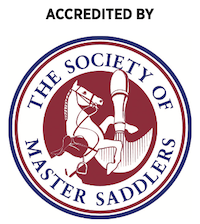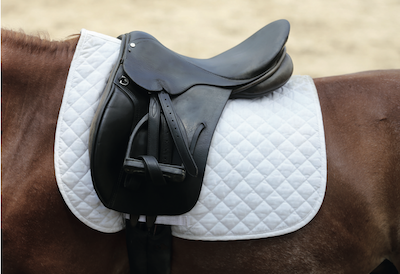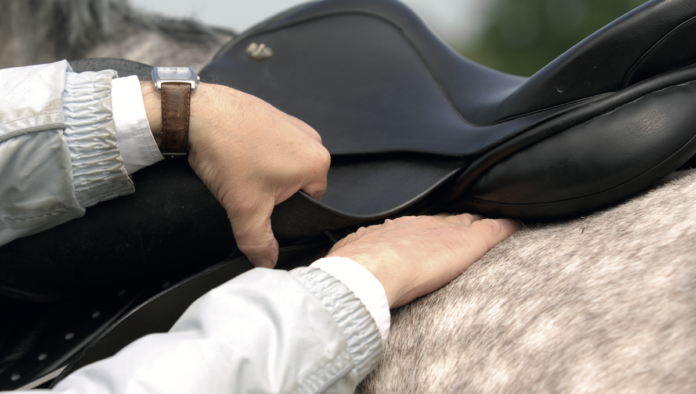
Equine welfare and the saddlery industry
By Catherine Baker, Master Saddler and Master Bridle Maker.
Saddle fitters who read the feature and submit correct answers to the quiz will be awarded one CPD point from the Society of Master Saddlers (SMS). SMS Registered Qualified Saddle Fitters are required to gain 15 CPD points, averaged over a two- year period.
‘The prime responsibility of the Society of Master Saddlers and its members is to the health and welfare of the horse and the safety of the rider....’
Does this sound familiar? All members of the SMS should recognise the first sentence of the Code of Conduct. The welfare of the equine should be the primary consideration of any saddler or saddlery fitter, whether they are fitting saddlery equipment or manufacturing items to be used on a horse.
WHAT IS WELFARE?
Welfare is the state of the animal’s well- being; good welfare is achieved when all the needs of the animal are being met.
The Animal Welfare Act 2006 requires any person to ensure that any horse, pony, donkey or mule for which they are responsible, whether on a permanent or a temporary basis:
• has a suitable environment to live in;
• has a healthy diet (including fresh clean water);
• is able to behave normally;
• has appropriate company; and
• is protected from pain, suffering, injury and disease.
These are called the Five Welfare Needs. They were adapted from the Five Freedoms which were originally developed in 1965. The Five Welfare Needs are embedded in the welfare legislation within the Act and this forms the basis for the Code of Practice for the welfare of horses, ponies, donkeys and their hybrids in England, with separate Codes of Practice in place in Wales and Scotland.
More recently, the Five Domains model has been developed as a result of research carried out by Prof David Mellor and Dr Cam Reid in Australia. Each of the first four domains, Nutrition, Environment, Health and Behaviour are evaluated before considering how they come together to impact the fifth domain, the mental state.
WHAT DOES THIS MEAN FOR THE SADDLERY INDUSTRY?
An SMS member’s first responsibility is to the horse; the primary Welfare Need that must be considered by the manufacturer and the fitter is that the equid must be protected from pain, suffering, injury and disease.
For those producing saddlery, consideration must be given to the design of the item and how it will impact the horse. Often design is led by consumer demand and the larger manufacturer has the difficult task of producing what the consumer wants at an affordable cost, without seeing the end product in use.
The design and the quality of materials used must be of a suitable standard so as not to cause the horse any pain, injury or suffering. But it is not just what we can see that must be taken into account.
Any internal fixings must also be of an appropriate standard to withstand the pressures of regular daily use; nor should they cause any harm to the horse should they come loose.
The bench saddler or manufacturer must create an item which is affordable, desirable and safe.
In comparison, the saddlery fitter has direct contact with the client and the horse. Their role is to ensure that the fit of any saddlery equipment does not cause any pain, suffering or injury.
The fitter must make sure that the horse can move freely and behave normally. A horse’s natural movement and behaviour can be influenced by ill-fitting tack. For example, the saddle can impede the shoulder, causing the horse to alter their gait; a tight noseband can affect the horse’s breathing or swallowing.
Not only do both these scenarios affect the horse in a physical way, they also affect the horse’s mental state as it struggles to cope with the discomfort or pain it’s experiencing.
DOES OUR RESPONSIBILITY STOP THERE?
Having good biosecurity practices in place helps to prevent the spread of equine infectious diseases. Following Covid-19, we’re now all used to washing our hands, wearing masks and using antibacterial hand gel. A similar approach with horses prevents cross contamination.
It’s a good idea to wipe down your equipment between each yard, and to keep a change of clothes and footwear in your car in case you come into contact with a potentially infected animal. Contaminated clothes should be put into a plastic bag and sealed, before being thoroughly cleaned.
WHAT IS CLASSED AS A WELFARE CONCERN AND WHAT CAN YOU DO TO HELP YOUR CLIENT?
Thinking back to the Five Welfare Needs, saddler fitters in particular may come across an equine whose welfare is not being met. A common example might be an inappropriate horse-rider combination, where the rider is too tall or large for the horse, or the horse may be recovering from injury or have insufficient strength or fitness to be able to carry the rider comfortably.

This can lead to difficulty when fitting saddles and needs dealing with tactfully. Good communication is key and can lead to an awkward conversation. However, saddlery fitters should be proactive where a horse’s welfare may be compromised.
In other cases, poor welfare could be due to a lack of owner knowledge and can often be put right by some helpful advice from a knowledgeable person. In this situation, a fitter with appropriate training and experience may offer the correct advice or guidance; or may refer the owner to the person most able to help, be that a coach, farrier, vet or equine welfare charity.
Referring clients to the latter can be quite daunting and again, good communication with your client is essential to help the horse. Organisations such as The Horse Trust, Redwings, World Horse Welfare or the RSPCA are happy to work with equine professionals such as SMS fitters and saddlers to ensure good welfare is maintained.
The removal of an equine is the last step in a long process, which begins with advice interventions before proceeding to ‘pressure’ interventions.
When the needs of an animal are not being met, the cause may be owners who are new or novice or simply lacking in horse care knowledge. The first step an equine welfare charity takes is to offer advice before a situation gets any worse. They will work with the owner to provide assistance and help them create a management plan. The charity may also refer the owner to an equine professional, such as a farrier or vet, and meet some of the initial costs.
“The welfare organisation may issue a non-statutory improvement notice”
The welfare organisation may issue a non-statutory improvement notice. This is an informal notice which explains what changes, if any, need to be made and record what advice has been given.
If the welfare concerns are more serious, or a non-statutory notice is ignored, a Statutory Improvement Notice may be issued. These can only be issued by an inspector appointed under the Animal Welfare Act if they have reason to believe that the animal has a need or needs which are not being met.
Finally, where there is unnecessary suffering, or a Statutory Improvement Notice is ignored, the horse will be seized, and the owner prosecuted. If found guilty, the owner may receive a ban on keeping animals, a fine, or prison/suspended prison sentence.











